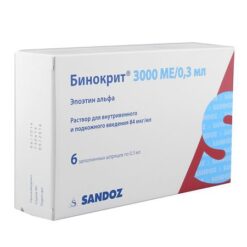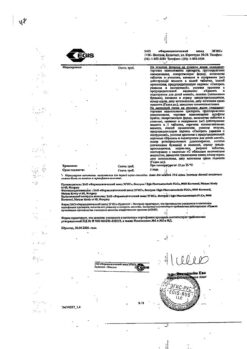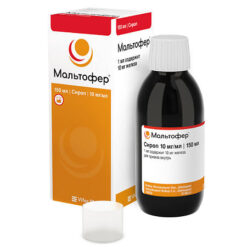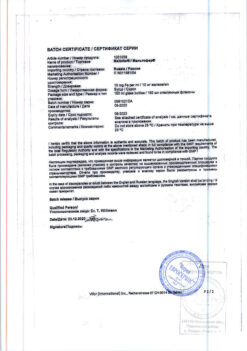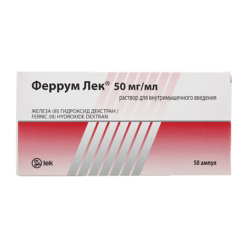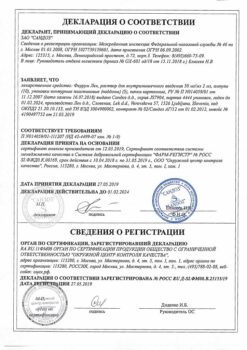No products in the cart.
Binocrit, 10000 me/ml 1 ml 6 pcs
€240.00 €234.85
Description
Erythropoietin is a glycoprotein that stimulates erythropoiesis and activates mitosis and maturation of erythrocytes from erythrocyte progenitor cells. The molecular weight of erythropoietin is about 32000-40000 Da. The protein fraction is about 58% of the molecular weight and includes 165 amino acids. Four hydrocarbon chains are linked to the protein by three N-glycoside bonds and one O-glycoside bond. Epoetin alfa, produced using genetically engineered technology, is a purified glycoprotein; its amino acid and carbohydrate composition is identical to that of human erythropoietin excreted from the urine of anemic patients.
Binocrit has the highest possible degree of purification according to modern technological capabilities. In particular, in quantitative analysis of the active ingredient of Binocrit, even trace amounts of cell lines are not detected.
The biological activity of epoetin alfa was confirmed in the experiment in vivo (researches were carried out on healthy rats and rats with anemia as well as on mice with polycythemia). After epoetin alfa injection, the number of erythrocytes, reticulocytes, hemoglobin concentration and 59Fe absorption rate increase. In in vitro studies, incubation with epoetin alfa revealed increased incorporation of 3H-thymidine in erythroid nucleus-containing cells of the spleen (in mouse spleen cell culture). Studies on human bone marrow cell culture showed that epoetin alfa specifically stimulates erythropoiesis and has no effect on leukopoiesis. Cytotoxic effects of erythropoietin on human bone marrow cells were not detected.
Erythropoietin is a growth factor that mainly stimulates the formation of red blood cells. Receptors for erythropoietin can be present on the surface of various tumor cells.
The administration of epoetin alfa is accompanied by an increase in hemoglobin, hematocrit, serum iron, contributes to improved blood supply to tissues and heart function. The most significant effect of epoetin alfa has been noted in anemia caused by chronic renal insufficiency (CKF) and also developed in patients with a number of malignant tumors and systemic diseases.
Pharmacokinetics
Intravenous administration
T1/2 epoetin alfa after repeated intravenous administration is about 4 hours in healthy volunteers and about 5 hours in patients with chronic renal failure. In children, T1/2 epoetin alfa is about 6 hours .
Subcutaneous administration
The plasma concentration of epoetin alfa is determined significantly lower by subcutaneous administration than by intravenous administration, the Tmax of epoetin alfa in plasma is about 12-18 hours after administration. Cmax epoetin alfa when administered subcutaneously is only 1/20th of the concentration when administered intravenously. The drug has no ability to cumulate – the concentration of epoetin alfa in blood plasma 24 hours after the first injection is the same as 24 hours after the last injection. When administered subcutaneously, the T1/2 of epoetin alfa is difficult to determine; it is about 24 hours. The bioavailability of epoetin alfa when administered subcutaneously is significantly lower than when administered intravenously and is about 20%.
Indications
Indications
anemia in adults and children caused by chronic renal failure, including:
– anemia due to chronic renal failure in children and adults on hemodialysis, as well as in adults on peritoneal dialysis;
– severe anemia of renal origin, accompanied by clinical symptoms in adults with renal failure who have not yet undergone hemodialysis;
treatment of anemia and reduction in the need for blood transfusions in adults receiving chemotherapy for solid tumors, malignant lymphoma or multiple myeloma, as well as in people at high risk of complications of blood transfusions due to a general serious condition (due to cardiovascular diseases, if anemia was noted before the start of chemotherapy);
to improve the efficiency of autologous blood transfusion as part of a pre-deposit blood collection program before surgery in patients with a hematocrit level of 33-39%, to facilitate the collection of autologous blood and to reduce the risk associated with the use of allogeneic blood transfusions if the expected need for transfusion exceeds the amount that can be obtained by autologous collection without the use of epoetin alfa. Treatment is indicated for patients with moderately severe anemia (with a hemoglobin concentration of 10–13 g/dL or 6.2–8.1 mmol/L), without iron deficiency, if significant blood loss is expected, as well as with extensive surgical interventions, when a large volume of blood transfusion may be required (5 or more volumes in men and 4 or more in women);
in order to reduce the degree of risk during allogeneic blood transfusion in adults who do not have iron deficiency, before elective orthopedic surgery, in the presence of a high risk of complications during blood transfusions. The use of the drug is limited – only in patients with moderate anemia (for example, with a hemoglobin concentration of 1013 g/dL), if they are not included in the autologous blood collection program before surgery with an expected blood loss of 900 to 1800 ml;
anemia in HIV-infected patients receiving zidovudine therapy with endogenous erythropoietin levels less than 500 IU/ml.
Pharmacological effect
Pharmacological effect
Erythropoietin is a glycoprotein that stimulates erythropoiesis, activates mitosis and maturation of red blood cells from erythrocyte progenitor cells. The molecular weight of erythropoietin is about 32,000–40,000 Da. The protein fraction makes up about 58% of the molecular weight and includes 165 amino acids. The four hydrocarbon chains are linked to the protein by three N-glycosidic bonds and one O-glycosidic bond. Epoetin alfa, produced using genetic engineering technology, is a purified glycoprotein; in amino acid and carbohydrate composition it is identical to human erythropoietin, isolated from the urine of patients with anemia.
Binocrit has the highest degree of purification in accordance with modern technological capabilities. In particular, when quantitatively analyzing the active substance of the drug Binocrit, even trace amounts of the cell lines on which the drug is produced are not determined.
The biological activity of epoetin alfa was confirmed in an in vivo experiment (studies were carried out on healthy rats and rats with anemia, as well as on mice with polycythemia). After administration of epoetin alfa, the number of red blood cells, reticulocytes, hemoglobin concentration and the rate of 59Fe absorption increase. In vitro studies with incubation with epoetin alfa revealed an increase in the incorporation of 3H-thymidine in erythroid nucleated spleen cells (in cultured mouse spleen cells). Studies on human bone marrow cell cultures have shown that epoetin alfa specifically stimulates erythropoiesis and has no effect on leukopoiesis. The cytotoxic effect of erythropoietin on human bone marrow cells has not been detected.
Erythropoietin is a growth factor that primarily stimulates the formation of red blood cells. Erythropoietin receptors may be present on the surface of various tumor cells.
The administration of epoetin alfa is accompanied by an increase in hemoglobin, hematocrit, serum iron, and improves blood supply to tissues and heart function. The most significant effect of epoetin alfa was observed in anemia caused by chronic renal failure (CRF), as well as in patients with a number of malignant neoplasms and systemic diseases.
Pharmacokinetics
Intravenous administration
T1/2 of epoetin alfa after repeated intravenous administration is about 4 hours in healthy volunteers and about 5 hours in patients with chronic renal failure. In children, T1/2 of epoetin alfa is about 6 hours.
Subcutaneous administration
With subcutaneous administration, the concentration of epoetin alfa in the blood plasma is determined to be significantly lower than with intravenous administration; the Tmax of epoetin alfa in the blood plasma is about 12–18 hours after administration. The Cmax of epoetin alfa when administered subcutaneously is only 1/20 of the concentration when administered intravenously. The drug does not have the ability to accumulate – the concentration of epoetin alfa in the blood plasma 24 hours after the first injection is determined to be the same as 24 hours after the last injection. When administered subcutaneously, T1/2 of epoetin alfa is difficult to determine; it is about 24 hours. The bioavailability of epoetin alfa when administered subcutaneously is significantly lower than when administered intravenously, and is about 20%.
Special instructions
Special instructions
When prescribing the drug Binocrit, blood pressure must be checked and strictly controlled in all patients. Epoetin alfa should be used with caution in patients with hypertension if they are not receiving appropriate treatment, if treatment is inadequate, or if the hypertension is poorly controlled. In this case, it may be necessary to initiate or intensify antihypertensive therapy that has already been used. If blood pressure cannot be normalized, treatment with epoetin alfa should be discontinued. Binocrit is used with caution in the presence of epilepsy and chronic liver failure.
Patients with chronic renal failure and cancer patients should regularly monitor hemoglobin levels until stable levels are achieved and periodically thereafter.
Careful monitoring of hemoglobin levels is mandatory for all patients due to the increased potential risk of thromboembolic complications and an increase in the number of fatal cases when patients were treated with hemoglobin levels exceeding the established norm for the use of the drug according to indications.
During treatment with Binocrit, a moderate dose-dependent increase in platelet count within normal limits may be observed. As the course of therapy continues, this indicator decreases again. During the first 8 weeks after starting therapy, it is recommended to regularly monitor platelet counts.
Before starting therapy, it is necessary to exclude all other causes of anemia (iron deficiency, hemolysis, blood loss, vitamin B12 or folic acid deficiency). In most cases, serum ferritin levels decrease while hematocrit increases.
All of these additional factors of anemia should also be taken into account when increasing the dose of Binocrit in patients with neoplasms.
During the perioperative period, it is necessary to carefully monitor all blood parameters.
PKKA
After several months or years of treatment with erythropoietin using subcutaneous injections, cases of development of antibody-mediated PRCA have been very rare. If patients experience a sharp decrease in the effectiveness of therapy due to a decrease in hemoglobin concentration (1-2 g/dL per month) against the background of an increased need for blood transfusions, it is necessary to check the reticulocyte count and investigate the typical reasons for the lack of response to the drug (for example, deficiency of iron, folic acid or vitamin B12, aluminum toxicity, infection or inflammation, bleeding or hemolysis).
If the reticulocyte count taking into account anemia (for example, the reticulocyte index) is low (If the appearance of PRCA mediated through antibodies to erythropoietin is suspected, therapy with Binocrit should be stopped immediately. Any other erythropoietin therapy is prohibited due to the risk of cross-reaction. If indicated, patients may be prescribed the necessary therapy, such as blood transfusions.
In the case of a paradoxical decrease in hemoglobin concentration and the development of severe anemia due to low reticulocyte counts, it is necessary to immediately stop treatment with epoetin and test for the presence of antibodies to erythropoietin. There is evidence of such manifestations in patients with hepatitis C who were treated with interferon and ribavirin simultaneously with epoetin. Epoetin is not intended to treat anemia due to hepatitis C.
Patients with chronic renal failure
Data on the immunogenicity of subcutaneous administration of Binocrit to patients at risk of developing antibody-mediated RCC, such as renal anemia, are limited. As a result, the drug must be administered intravenously to patients with renal anemia.
To minimize the risk of increased hypertension in patients with chronic renal failure, the rate of increase in hemoglobin should be approximately 1 g/dL (0.62 mmol/L) per month and should not exceed 2 g/dL (1.25 mmol/L) per month.
In patients with chronic renal failure, the hemoglobin concentration at the maintenance stage of treatment should not exceed the ULN recommended in the section “Method of administration and dosage”. The results of clinical studies have shown an increased risk of fatal outcomes and severe cardiovascular disorders when erythropoiesis-stimulating drugs are administered to increase the hemoglobin concentration to more than 12 g/dL (7.5 mmol/L).
In clinical trials under controlled conditions, no significant benefit was found associated with the use of epoetins when increasing hemoglobin concentrations above the level necessary to control symptoms of anemia and prevent blood transfusions. Cases of shunt thrombosis have been reported in patients on hemodialysis, in particular with a tendency to hypotension or due to the formation of arteriovenous fistulas (for example, stenosis, aneurysm, etc.). In such patients, early shunt correction and thrombosis prevention, for example with acetylsalicylic acid, are recommended.
In some cases, hyperkalemia was observed. Treatment of anemia may result in increased appetite and increased potassium and protein requirements. The dialysis regimen should be periodically adjusted to maintain the required levels of urea, creatinine and potassium. In patients with chronic renal failure, it is necessary to check the content of electrolytes in the blood serum. If elevated (or rising) serum potassium levels are detected, the advisability of discontinuing epoetin alfa treatment should be assessed until potassium levels normalize.
During treatment with epoetin alfa, an increase in the dose of heparin during hemodialysis is often required due to an increase in hematocrit. If heparinization cannot be maximally effective, discontinuation of the dialysis regimen may be necessary.
Treatment of anemia with epoetin alfa in adult patients with renal failure not already on dialysis has been reported to not cause progression of renal failure.
Adult cancer patients with symptomatic anemia undergoing chemotherapy
In some clinical situations, blood transfusions should be used to treat anemia in patients with cancer. The decision to prescribe recombinant erythropoietins must be made taking into account the balance of benefits and possible risks for each patient individually and the characteristics of the clinical situation. The following factors should be taken into account: the type and stage of development of the neoplasm; degree of anemia; life expectancy; the setting in which the patient will be treated; wishes of the patient himself.
When assessing the appropriateness of epoetin alfa therapy (risk of blood transfusion for the patient) in cancer patients receiving chemotherapy, it is necessary to take into account the delay of 2-3 weeks after the administration of epoetin alfa before the formation of red blood cells against the background of erythropoietin stimulation.
In order to minimize the risk of developing thrombotic phenomena, it is necessary to ensure that the hemoglobin level and the rate of its increase do not exceed acceptable values.
Due to the increased incidence of venous thrombotic complications in cancer patients receiving erythropoiesis-stimulating drugs, the risks and benefits of treatment with epoetin alfa should be carefully assessed, especially in cancer patients with an increased risk of developing venous thrombotic complications, such as obesity or a family history of venous thrombotic diseases (including deep venous thrombosis or pulmonary embolism).
Adult patients participating in a pre-surgical autologous blood collection program
All special precautions relevant to the conduct of autologous blood collection programs must be observed, especially when routine blood transfusions are performed.
Patients undergoing elective orthopedic surgery
For patients undergoing elective orthopedic surgery, the cause of the anemia should be determined and the anemia treated if possible before initiating epoetin alfa therapy. Such patients may be at risk of developing thrombotic events, which must be carefully assessed when prescribing treatment for patients in this group.
Patients undergoing elective orthopedic surgery should receive adequate antithrombotic prophylaxis due to the risk of developing venous thrombotic complications in surgical patients, especially those suffering from cardiovascular disease. In addition, special precautions must be taken in patients with a predisposition to developing deep vein thrombosis of the extremities. Patients with an initial hemoglobin level >13 g/dL (>8.1 mmol/L) are at increased risk of postoperative thrombotic/venous complications. As a result, the drug should not be prescribed to patients with an initial hemoglobin level of >13 g/dL (>8.1 mmol/L).
Excipients
This medicinal product contains less than 1 mmol sodium (23 mg) per prefilled syringe, i.e. virtually sodium free.
Active ingredient
Active ingredient
Epoetin alfa
Composition
Composition
1 ml of solution for intravenous and subcutaneous administration contains:
active ingredient:
epoetin alfa 84 mcg;
excipients:
sodium dihydrogen phosphate dihydrate,
sodium hydrogen phosphate dihydrate,
sodium chloride,
glycine,
polysorbate 80,
hydrochloric acid,
sodium hydroxide,
water for injections
Pregnancy
Pregnancy
There are no adequately controlled studies of the use of epoetin alfa in women during pregnancy. Animal studies have shown reproductive toxicity.
As a result, patients with chronic renal failure should use Binocrit during pregnancy only if the expected benefit to the mother significantly outweighs the risk to the fetus.
The use of epoetin alfa is not recommended during pregnancy or lactation in patients participating in an autologous blood collection program before surgery.
Contraindications
Contraindications
hypersensitivity to the active substance and excipients included in the drug;
partial red cell aplasia (PRCA), which occurred after treatment with erythropoietin;
uncontrolled arterial hypertension;
patients who, for any reason, cannot receive effective treatment to prevent thrombosis;
myocardial infarction or stroke that occurred within 1 month before the planned treatment; unstable angina; patients with a high risk of deep vein thrombosis and a history of thromboembolic disease (as part of increasing the effectiveness of autologous blood transfusion);
severe damage to the coronary, peripheral arteries, carotid arteries, as well as cerebral vessels, incl. in patients who have recently suffered a myocardial infarction or stroke (as part of a pre-deposit blood collection program before major surgery and not participating in an autologous blood transfusion program).
With caution: malignant neoplasms, epileptic syndrome (including a history), chronic renal and liver failure, thrombocytosis, thrombosis (history), acute blood loss, sickle cell anemia, hemolytic anemia, iron, B12 or folate deficiency conditions.
Side Effects
Side Effects
The side effects presented below are distributed according to the classification of organs and systems and by frequency of occurrence: very often (≥1/10); often (≥1/100–
From the blood and lymphatic system: infrequently – thrombocythemia (in patients with malignant neoplasms); frequency unknown – antibody-mediated PRCA1, thrombocythemia (in patients with chronic renal failure).
From the immune system: frequency unknown – anaphylactic reaction, hypersensitivity.
From the nervous system: very often – headache (in patients with malignant neoplasms); often – convulsions (in patients with chronic renal failure), headache (in patients with chronic renal failure); uncommon – hemorrhagic stroke2, convulsions (in patients with malignant neoplasms); frequency unknown – stroke2, hypertensive encephalopathy, transient ischemic attacks.
From the organ of vision: frequency unknown – retinal thrombosis.
From the cardiovascular system: often – deep vein thrombosis of the lower extremities (in patients with malignant neoplasms); increased blood pressure; frequency unknown – deep vein thrombosis of the lower extremities (in patients with chronic renal failure), arterial thrombosis, hypertensive crisis.
From the respiratory system: often – pulmonary embolism2 (in patients with malignant neoplasms); frequency unknown – pulmonary embolism2 (in patients with chronic renal failure).
From the gastrointestinal tract: very often – nausea; often – diarrhea (in patients with neoplasms), vomiting; infrequently – diarrhea (in patients with chronic renal failure).
From the skin and its appendages: often – skin rash; frequency unknown – angioedema, urticaria.
From the musculoskeletal system: very often – arthralgia (with chronic renal failure); often – arthralgia (in patients with malignant neoplasms); uncommon – myalgia (in patients with malignant neoplasms); frequency unknown – myalgia (with chronic renal failure).
Congenital, familial/genetic disorders: frequency unknown – porphyria.
From the body as a whole: very often – hyperthermia (in patients with malignant neoplasms); flu-like condition (with chronic renal failure); often – a flu-like condition (in patients with malignant neoplasms); frequency unknown – ineffectiveness of the drug, peripheral edema, hyperthermia (with chronic renal failure), reactions at the injection site.
Laboratory indicators: frequency unknown – antibodies to erythropoietin1.
Others: often – thrombosis of the dialysis equipment shunt (in patients with chronic renal failure).
1 The frequency of occurrences cannot be estimated from clinical studies.
2 Including fatalities.
Interaction
Interaction
There is no data on the interaction of epoetin alfa with other drugs. However, when used simultaneously with cyclosporine, an interaction is possible, since the drug binds to red blood cells.
If treatment with Binocrit is carried out simultaneously with cyclosporine, it is necessary to monitor the concentration of cyclosporine depending on the degree of increase in hematocrit.
There is no data on the interaction between epoetin alfa and granulocyte colony-stimulating factor (G-CSF) or granulocyte-monocyte colony-stimulating factor (GM-CSF).
To avoid incompatibility or decreased activity, it is not recommended to mix with solutions and other medications.
Overdose
Overdose
The therapeutic range of the drug is wide.
In case of an overdose, symptoms may occur that reflect the extreme degree of manifestation of the pharmacological action of the hormone (increased hemoglobin concentration or hematocrit).
If hemoglobin or hematocrit levels are exceptionally high, phlebotomy may be used.
If necessary, symptomatic therapy is prescribed.
Storage conditions
Storage conditions
At 2–8 °C (do not freeze).
Shelf life
Shelf life
2 years.
Manufacturer
Manufacturer
IDT Biology GmbH, Germany
Additional information
| Shelf life | 2 years. |
|---|---|
| Conditions of storage | At 2-8 °C (do not freeze). |
| Manufacturer | I.D.T. Biology GmbH, Germany |
| Medication form | solution |
| Brand | I.D.T. Biology GmbH |
Other forms…
Related products
Buy Binocrit, 10000 me/ml 1 ml 6 pcs with delivery to USA, UK, Europe and over 120 other countries.


